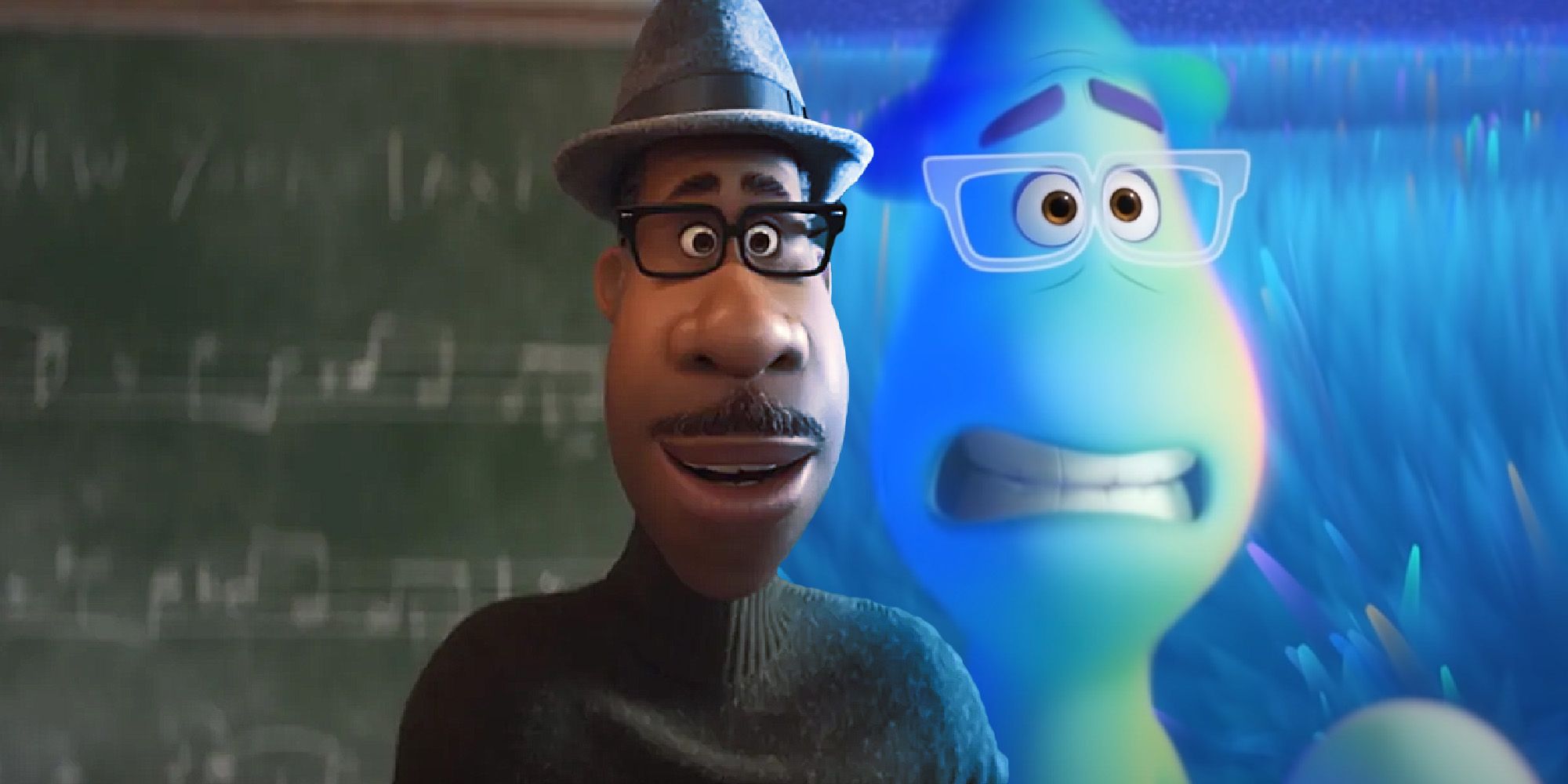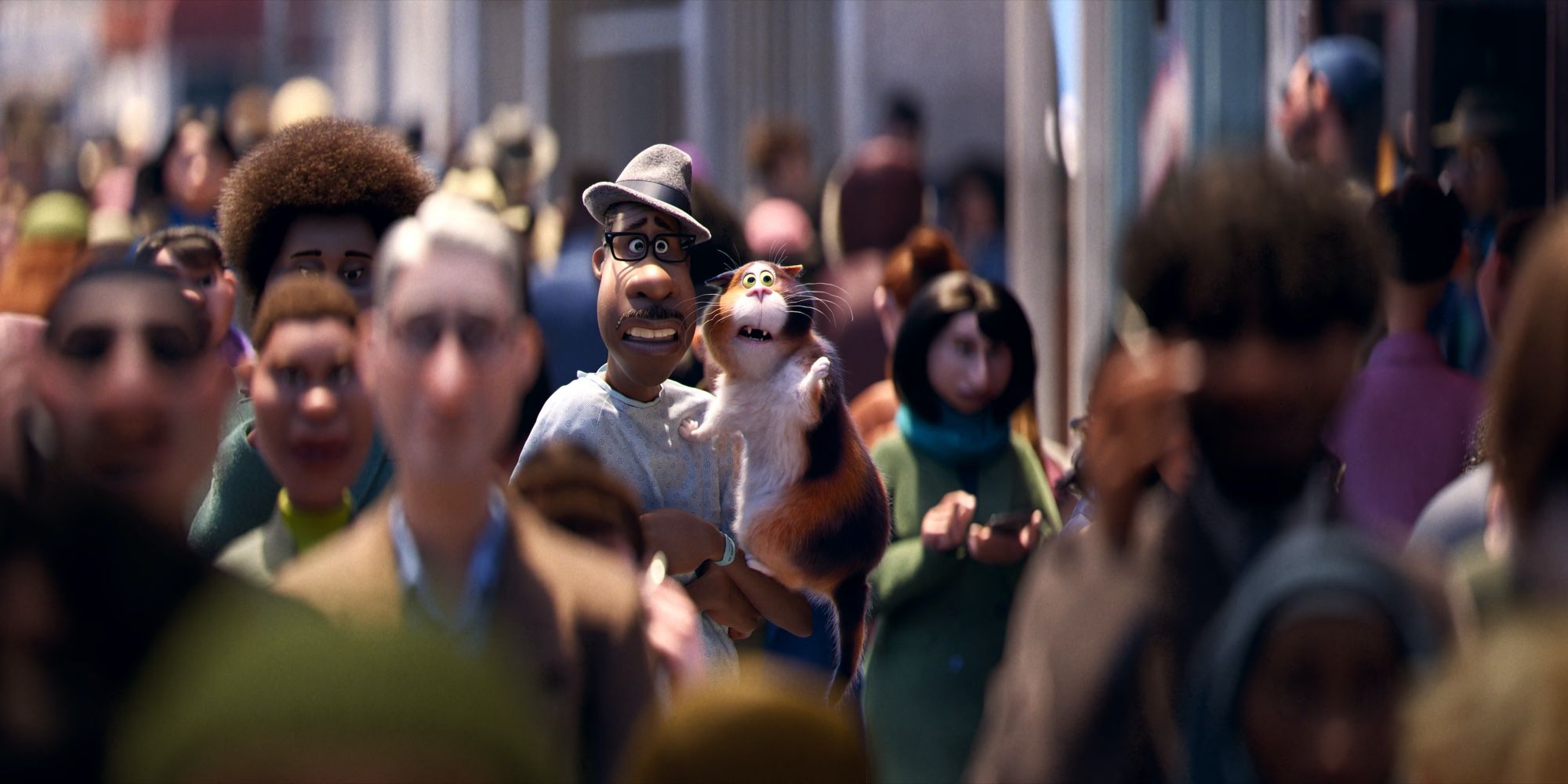Pixar's Soul may have made history, but it still has some racial issues. When the first trailer was released, there were a few eyebrows raised after learning that the character of Joe Gardner - Pixar's first Black lead - would appear as a blue-green creature. While the trippy film has been met with a largely positive response since its Disney+ release, the controversial utilization of the problematic trope of separating Black characters from their bodies (and others) has inspired some of Soul's most nuanced and complicated discourse.
Soul follows Joe Gardner (voiced by Jamie Foxx), a Black middle school band teacher and talented jazz musician who, after landing the gig of a lifetime, lands in coma in the wake of a freak accident. Unwilling to enter into the "Great Beyond," Joe's soul-self lands in the neighboring "Great Before," a plane of existence where new souls are prepared for human life. Tasked with mentoring the unruly soul, 22 (Tina Fey), Joe and his charge end up back on Earth (22 is accidentally in Joe's body while Joe finds himself inside a conveniently adjacent therapy cat) before being found out and brought back to their metaphysical limbo. After some setbacks, Joe eventually persuades 22 to live her life though it means that he will die, giving up his hard-won dream in the process. Soul ends with Joe being given a second chance, but what he will do with that opportunity is left ambiguous. There are some issues here.
As the trailer implied, Joe spends most of the film's first act in his diminutive blue soul-form and then its second as a cat (a detail left out of the marketing material). Soul's doubling down on this particular plot contrivance - which in essence splits and separates a person of color from their racial identity - is difficult to rationalize, especially considering animation history. Even in recent years, The Emperor's New Groove transmutes an Incan king into a llama, Brother Bear morphs an Inuit leading character into a grizzly, and Will Smith's character in Spies in Disguise changes into a pigeon. Most infamously, Disney's The Princess and the Frog transforms Tiana (the studio's first-ever Black Disney princess) into a frog for the majority of her story. While Soul's main character is a significant milestone in terms of representation, it is unfortunate that it will also be added to the list. As Nightmarish Conjurings' review of the film rightly points out, "Overall, Joe is a Black man in his Black body for less than 20 minutes in the entire film," pointing to the main character's general lack of agency throughout the film.
A Number Of Black Critics Pointed Out Joe's Lack Of Agency In Soul
However, another complication exists in the fact that 22 (though a disembodied soul, is still voiced by a white woman) spends much of the Soul's second act inhabiting Joe's body. Connecting with his student, relating to his barber, and mending fences with his mother, Joe, as a cat, is forced to watch as 22 "fixes" his life for him. The whole scenario, though absurd, shares some DNA with the "white savior" trope. Charles Pulliam-Moore articulates the issue best in his article on Gizmodo, writing, "[T]he film distinctly feels as if it’s taken you into Black spaces where Joe’s interiority is more easily recognizable and expressive. But Soul frames these moments as belonging to 22 in a way that detracts from the movie’s message because they imply that Joe himself was never properly comfortable in them prior to his adventure." While Pulliam-Moore agrees that the studio's aesthetic representation of Soul's black characters was gorgeous, the film's drift toward white-centric narratives often gets in its way.
Soul’s own world-building contributes to the messiness. Presented as homogenous blue-green creatures (who are presumably intended to be raceless and genderless), the souls are shown to be meaningfully shaped prior to their life on Earth. The film tries hard to assert a universal lived experience, an idea that definitionally diminishes the very real presence of inequality in our own world and the impact it plays (in opportunity, in privilege, and in finding one’s “spark”). In other words, the film's emphasis on universality ultimately undercuts Joe's individuality.
In fact, despite its inclusion of diverse representation, Soul - which is ostensibly asking deep questions about identity - stays strangely uninterested in exploring Joe's identity as a Black man throughout the story. As Pulliam-Moore points out, "Soul comes across less like an earnest and casual celebration of everyday Blackness, and more like a twee depiction of it that’s meant for white audiences’ consumption." Exacerbated by the film's near forcible separation of Joe from his blackness (literally and figuratively) and with so little attention paid to his backstory, it is hard to argue with that read.
Other Black Critics Acknowledge Soul's Problems While Celebrating The Rest
Despite not necessarily sticking the landing on the treatment of its main character, some Black critics have applauded the film and its overall significance. Rendy Jones of Rendy Reviews (who also makes mention of the film's aforementioned ickiness surrounding Joe's removal from his body) gives well-deserved accolades to Soul's co-director and co-writer Kemp Powers, noting, "His voice is so strong and authentic as a storyteller that throughout the second act, which is primarily set on Earth, you can easily identify which pieces Powers controlled in the direction of the story." Additionally, Geeks of Color calls out Soul's cultural significance writing, "Pixar has another hit on its hands with Soul, and hopefully, this paves the way for more Black leads in Disney and Pixar films."
The fact remains that with relatively so few characters of color featured prominently in animation, each one counts enormously, especially when created by a machine as far-reaching as Disney/Pixar. Soul, a resonant and well-crafted film, inches toward a reality in which the representation onscreen truly mirrors that of its audience, but also reminds us of just how strongly some highly reductive tropes permeate modern storytelling. From here on out, diversity should be celebrated unreservedly, not magically hidden away in bodies that fail to truly represent those who have waited on these stories for far too long.
Next: Soul: All Easter Eggs & Secret Pixar References Explained


